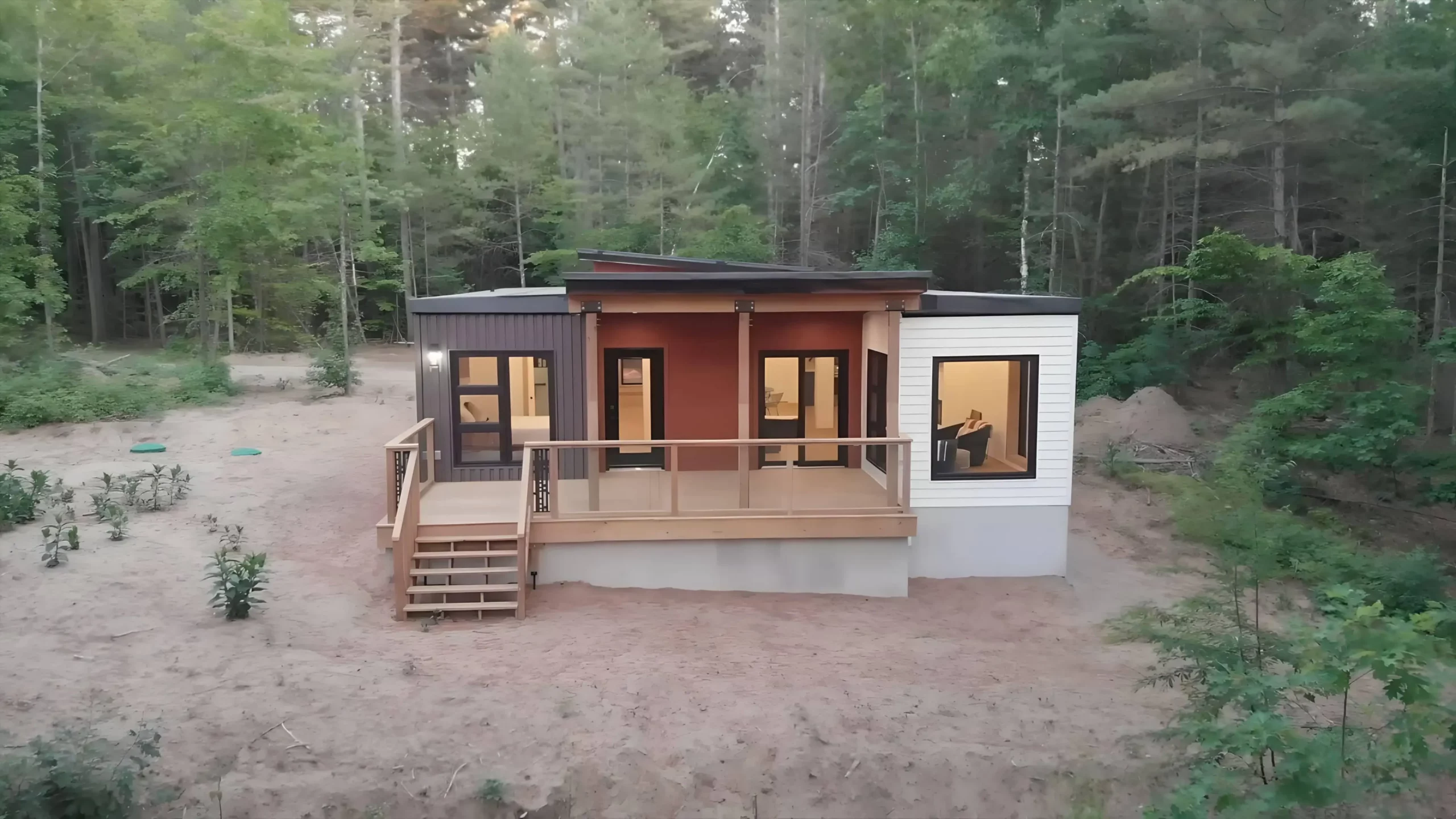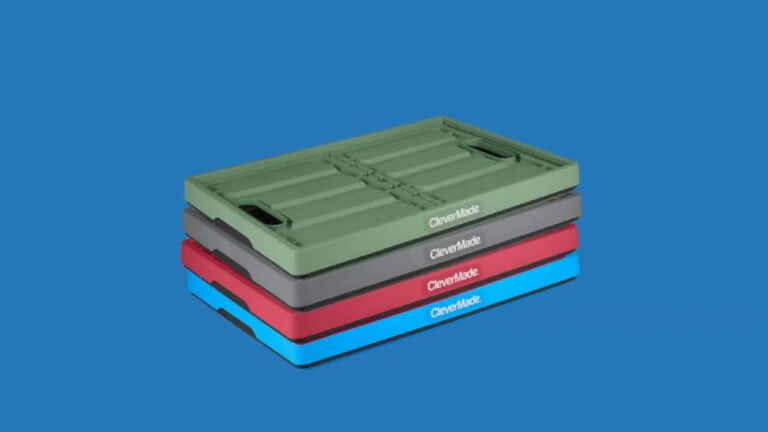Shipping Container Homes: 10 Key Factors Before Investing
Shipping container homes have been gaining popularity as a unique, eco-friendly, and cost-effective solution for modern living. As someone who has researched this trend extensively, I’ve come to understand the key factors before investing in this type of property.
In the following paragraphs, I will share my insights on what you should think about before taking the leap into container home ownership.
Happy reading!
Shipping Container Homes: Are They Worth the Investment? 10 Key Factors to Consider
1 – Size constraints
When it comes to investing in a shipping container home, one of the most obvious issues you need to consider is the size constraints. Standard shipping containers are typically 20 or 40 feet long and 8 feet wide. These might sound spacious, but once you start fitting them out for living, the space tightens significantly.
To make the container livable, there’s a lot of subtracting that happens from the initial measurements. You’ll need to insulate the container, add mechanical systems, plumbing, electrical systems, sprinklers, and flooring. All of these necessary installations inevitably eat up the available space, shaving off up to a foot of the total height and six inches off each side.
This leaves you with a rather snug living area – a reality that can be both a challenge and a fascinating puzzle to solve.
For those who desire a little more headroom, you can follow the example of others who’ve walked this path before. Some folks, like Benjamin Ojeda who created a home in Joshua Tree, California, chose to order custom shipping containers that are nine and half feet tall.
This extra foot can make a world of difference, but it’s also worth noting that it comes with a higher price tag.
The size constraints are not necessarily a negative aspect though.
In fact, they can be seen as an invitation to be creative and thoughtful with your design choices. By understanding these constraints, you can better plan your space and avoid potential disappointments later on.
So before you dive into the world of shipping container homes, you need to be honest about your spatial needs, and carefully consider whether a shipping container can satisfy them.
The beauty of this type of investment is that it pushes you to think differently about space – a skill that can serve you well in other aspects of life too.
2 – Structural challenges
One vital aspect you need to be aware of when thinking about investing in shipping container homes relates to the structural challenges that such homes pose. The fact is, a shipping container works as a system – while it may seem that every part of the box is structural, this isn’t the case.
Every modification you make to a shipping container – every cut for plumbing, windows, doors, roof openings into its structural frame, or corrugated metal siding – has the potential to compromise its structural integrity. This means that every modification you make may need to be reinforced with additional materials such as metal or wood, adding complexity and potentially cost to the project.
For instance, to add insulation to the inside of a container, you would need to frame out the walls with wood and finish the interior with drywall, just like you would in a typical home construction.
Moreover, the misconception that shipping containers can easily support cantilevers should be addressed. While shipping containers are designed to be stacked on top of each other like LEGO building blocks, if you decide not to stack the containers on their corners, you’ll need to reinforce them with heavy, and often expensive, steel beams.
The four corner posts of the containers should ideally align with the corner posts of the container above or below for maximum security. The rails at the top and the roof of the container are not structural, and the roof itself, made of lightweight steel, can dent easily.
When you see those double-wide container homes on YouTube with an entire sidewall removed to create more space, it’s important to realize that they’ve likely required significant and costly steel reinforcement. At that point, the shipping container is essentially being used for its aesthetic appeal rather than its inherent structural properties.
3 – Poor thermal insulation
The third key consideration when thinking about investing in shipping container homes relates to thermal insulation. It’s crucial to understand that steel, while durable and resilient, doesn’t perform well as an insulator. This characteristic of steel containers leads to some potential problems.
You see, due to the poor insulation properties of steel, the inside of these containers can become extremely hot in the summer and bitterly cold in the winter. If you choose to insulate the inside of the containers, there’s a significant risk of condensation buildup, as the warm exterior air meets the cooler air inside, or vice versa. This moisture can potentially lead to mold and rot inside the home, which is an issue you’d certainly want to avoid.
One solution to this problem is to insulate the outside of the containers and add additional cladding, as some people have chosen to do. However, this approach presents another challenge. By adding exterior insulation and cladding, you might end up losing the appealing corrugated metal aesthetic that makes shipping container homes so distinctive.
4 – Health risks
When considering investing in shipping container homes, a factor that you must be mindful of is potential health risks. It’s important to remember that many containers have a past life, and that past may pose some issues.
For example, it’s nearly impossible to know precisely what cargo a used container has transported during its service. This means there’s a risk that the container could have carried toxic substances, such as pesticides or fumigants, which could potentially have leaked into the wooden floorboards, presenting a health risk.
This concern is serious enough that some jurisdictions, like California, only allow single-use containers to be repurposed into homes, to better control and understand what the container has transported in its limited service.
Furthermore, the paint used on these shipping containers is designed to withstand harsh oceanic conditions, meaning it may contain elements like phosphorous and chromium. These elements, under certain conditions, can pose health risks, including potential carcinogenic effects.
5 – Location limitations
Location plays a crucial role when considering investing in a shipping container home. It’s a key factor that may determine the feasibility and practicality of your investment.
For starters, if you’re based near coastal regions or port cities, where shipping containers are readily available, it might make perfect sense. However, if your desired location is more inland, the cost of transporting the shipping container to your land may become prohibitive.
It’s also essential to consider the environmental implications and the costs associated with the materials used. In many cases, building with locally available materials may be more eco-friendly and cost-effective. For instance, in the States, wood construction tends to be cheaper. However, in other countries, it could be more practical to use CMU block or clay bricks.
Vernacular construction methods, which are adapted to the local climate and available resources, often make the most sense. However, there are certainly situations where shipping container housing could be advantageous, such as in areas with material shortages or those recovering from natural disasters, where prefab, factory-built, temporary shelters could be beneficial.
Ultimately, understanding the specific constraints and opportunities of your location is a vital part of the decision-making process when investing in a shipping container home.
6 – Environmental concerns
Before you decide to invest in a shipping container home, it’s important to take into account the environmental impact. There’s a common perception that using shipping containers for housing is a highly sustainable practice. While this can be true in some instances, it’s not always the case.
If you’re repurposing a used shipping container that would otherwise end up in a landfill, that’s one thing. However, if you’re using a brand-new or one-time-use shipping container, the environmental benefits become less clear. These containers could arguably be put to better use serving their intended purpose of transporting goods across oceans.
Additionally, it’s crucial to consider the condition of the shipping containers. Given the rough treatment they often receive at sea, it’s not uncommon to find used containers in less than ideal condition. This means you might end up having to buy a new one, which would have a higher environmental impact.
Thermal insulation poses another environmental challenge. Due to the high thermal conductivity of steel, insulating these containers requires the use of materials that may not be the most eco-friendly, such as spray foam, polystyrene, or fiberglass insulation.
Lastly, the carbon footprint of your container home is another significant aspect to consider. The process of manufacturing steel and reinforcing the container’s structure can be more carbon-intensive than using traditional wood construction.
Therefore, while the idea of a shipping container home might initially seem environmentally friendly, it’s crucial to consider all these factors before proceeding with such an investment. It’s about making an informed decision, understanding that “sustainability” is a complex issue that extends beyond just repurposing a shipping container.
7 – Cost implications
There’s a prevailing notion that shipping container homes are a cost-effective solution to the current housing crunch, but we need to analyze this claim in-depth. While the concept of converting a shipping container into a home may initially seem like an economical choice, the reality might be different.
You see, transforming a shipping container into a livable space requires significant modifications. You’ll have to insulate it, add plumbing, electricity, and other systems, not to mention customizing it to suit your living needs. These modifications aren’t cheap, and the costs can quickly add up.
From a purely financial perspective, other construction methods such as wooden structures might be a more viable option, particularly for large-scale projects like homeless shelters. It’s not that shipping container homes can’t be somewhat cheaper – perhaps saving around 20% compared to traditional construction – but the savings may not be as significant as one might initially expect.
Remember, investing in a shipping container home isn’t just about the initial price of the container itself. It’s also about the subsequent costs associated with transforming it into a cozy, livable space. It’s crucial to weigh these costs before making a decision, as they may offset the initial savings that a shipping container home seems to offer.
8 – Limited design flexibility
Embarking on the journey of owning a shipping container home can be exciting. The prospect of converting an industrial box into a warm, inviting space is intriguing. However, it’s important for you to understand that this unique type of housing does come with its own set of limitations, particularly in terms of design flexibility.
Shipping containers have a rigid structure and a uniform shape, which can be somewhat limiting when it comes to design possibilities and customization options. They are, after all, built for the primary purpose of transporting goods rather than accommodating human habitation.
This fixed structure can make it a real challenge to create unique layouts or cater to specific architectural needs. Whether it’s a desire for wider rooms, high ceilings, or a non-linear layout, you may find your vision is difficult to realize within the constraints of a shipping container.
In contrast, traditional homes can be constructed in a myriad of shapes and sizes, with a wealth of customization options available. With shipping container homes, however, the design is inherently tied to the shape and size of the container. As such, it’s critical for you to assess whether these limitations align with your living preferences and lifestyle needs.
9 – Potential maintenance issues
One aspect that’s easy to overlook when envisioning your dream shipping container home is the potential for maintenance issues down the line. Yes, these structures are robust and built to withstand harsh conditions at sea, but when repurposed as homes, they can encounter a range of issues that require attention.
A primary concern with shipping container homes is their susceptibility to structural problems such as rust and corrosion over time. Containers are made of steel, a material that, while durable, can rust when exposed to moisture. This is particularly problematic in regions with high humidity or harsh climates. Rust not only detracts from the aesthetic of the container but can also compromise its structural integrity if left untreated.
In addition, shipping container homes may also experience issues such as leaks. Remember, these containers are initially designed for shipping goods, not for housing, and thus, they may not be fully watertight. Leaks can lead to further problems like interior damage or mold growth.
Addressing these issues is not only time-consuming, but it can also be quite costly. From hiring professionals for repairs to purchasing necessary materials for maintenance, the costs can add up quickly. Therefore, as a potential investor, you need to take these potential maintenance issues into account when considering a shipping container home. You must be prepared for the ongoing commitment required to keep your unique dwelling in optimal condition.
10 – Limited resale value
The unique appeal of shipping container homes isn’t without its potential downsides. One that might give you pause is the potentially limited resale value compared to traditional homes. The market for such dwellings can be niche, limiting the pool of interested buyers when it comes time to sell.
While these homes offer a unique aesthetic and eco-friendly appeal, their unconventional nature can raise concerns among potential buyers. Questions about modifications, structural integrity, and long-term maintenance can deter some from considering a shipping container home as a viable option.
Given the specific considerations and potential challenges associated with shipping container homes, buyers may be more hesitant compared to when purchasing a traditional home.
This reality can make it more difficult to recoup your initial investment or even make a profit when it comes time to sell your shipping container home. Unlike conventional homes, where upgrades and renovations can significantly increase the property’s value, shipping container homes may not yield the same return on investment due to their unique construction and associated considerations.
Therefore, before embarking on the journey of investing in a shipping container home, consider your long-term plans. If you anticipate wanting to sell in the future, bear in mind that the resale value and market demand may not be as robust as for more traditionally constructed homes.
Shipping Container Homes: Final Thoughts
Reflecting on the ten keys we’ve explored, there’s no doubt that shipping container homes offer a unique, modern, and eco-friendly alternative to traditional housing. However, like any investment, they come with their own set of challenges and considerations that can’t be overlooked.
It’s crucial to delve into the container’s history, consider its potential health impact, and be aware of structural limitations. It’s not just about the initial appeal but understanding the full picture, from potential health risks and thermal insulation issues to long-term maintenance concerns and resale value.
These homes present intriguing design and environmental benefits but equally require due diligence and thoughtful planning. They may necessitate significant modifications, which could impact structural integrity and incur additional costs. Plus, their unique nature could potentially limit their appeal in the resale market.
This overview is not intended to dissuade you from the allure of shipping container homes, but rather to underscore the importance of comprehensive understanding before diving in. Informed decisions are always the best course of action in any investment journey, and shipping container homes are no exception.
As for me, having weighed up all these factors, I’ve decided that I’m not ready to invest in a shipping container home at this point.
It’s a decision based not only on my individual needs and preferences but also a careful consideration of the insights and key points shared.
Your journey might differ, and that’s the beauty of home ownership – finding the right fit for your unique needs!
Sources







